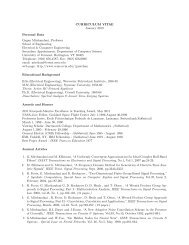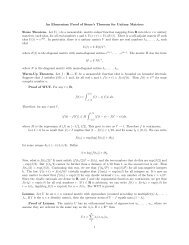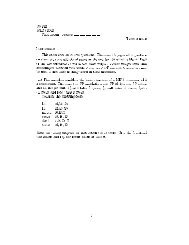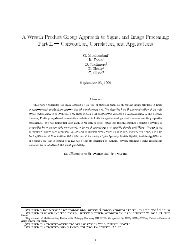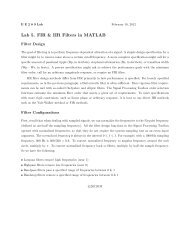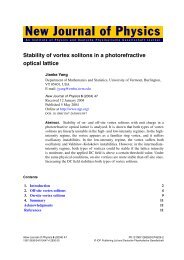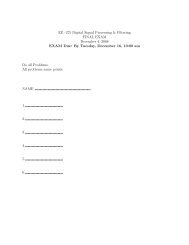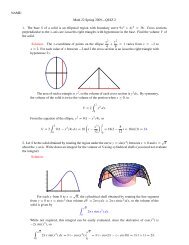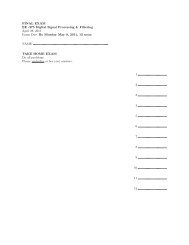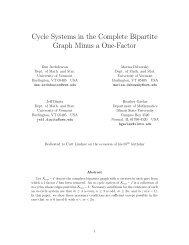Weighted inequalities for gradients on non-smooth domains ...
Weighted inequalities for gradients on non-smooth domains ...
Weighted inequalities for gradients on non-smooth domains ...
Create successful ePaper yourself
Turn your PDF publications into a flip-book with our unique Google optimized e-Paper software.
Thus, our problem has now reduced to c<strong>on</strong>trolling the size of ∑ i: |F (P i )|>1 ω(P i).The reader may w<strong>on</strong>der why we throw the cubes I k into P at all, since <strong>on</strong>ly the cubes J l areneeded to cover {x ∈ Q 0 : F ∗ (x) > 1, G ∗ (x) ≤ γ}. The reas<strong>on</strong> will so<strong>on</strong> become apparent. But,essentially:we use the family {I k } k to c<strong>on</strong>trol the size of G ∗ (x) globally <strong>on</strong> Q 0 (i.e., even at pointswhere F ∗ (x) ≤ 1). This is very much in the spirit of the proof of the classical good-λ inequality<str<strong>on</strong>g>for</str<strong>on</strong>g> the dyadic square functi<strong>on</strong>.Define F 1 = {Q ⊂ Q 0 : ∀i(Q ⊄ P i )} and F 2 = {Q ⊂ Q 0 : Q ⊂ P i <str<strong>on</strong>g>for</str<strong>on</strong>g> some i}; andsetf i = ∑ Q∈F iλ Q φ (Q) <str<strong>on</strong>g>for</str<strong>on</strong>g> i =1, 2. It is obvious that f = f 1 + f 2 . Corresp<strong>on</strong>ding to f 1 and f 2 ,wedefineF i (I,x)=∑λ Q φ (Q) (x)Q:Q∈S(I)Q∈F iF i (I) =F i (I,x I )Fi ∗ (x) = sup |F i (I)|I:x∈I⎛⎡⎜∑∞∑G i (I,x)= ⎝ |λ Q | 2 ⎣Q∈S(I)Q∈F ij=02 −j(2α−τ)⎤⎞ω(2 j Q) χ R j (Q)(x) ⎦⎟⎠G i (I) =G i (I,x I )G ∗ i (x) = sup G i (I);I:x∈Iwhere, as be<str<strong>on</strong>g>for</str<strong>on</strong>g>e, we do not define F i (I,x)orG i (I,x)<str<strong>on</strong>g>for</str<strong>on</strong>g>x/∈ I.Be<str<strong>on</strong>g>for</str<strong>on</strong>g>e going <strong>on</strong>, let us note—what is easy to see—that F (I,x) =F 1 (I,x)+F 2 (I,x) andG(I,x) ≤ G 1 (I,x)+G 2 (I,x). It is also easy to see that that each G i (I,x) ≤ G(I,x).For any cube Q, defineC(Q) ≡{x ∈ Q : |x − x Q | 1ω(C(P i )).1/2Clearly,∑∑∑ω(C(P i )) ≤ω(C(P i )) +ω(C(P i ))i: |F (P i )|>1i: |F 1 (P i )|>1/2i: |F 2 (P i )|>1/2≡ (I)+(II).Let us c<strong>on</strong>sider (I) first. EachP i satisfies G(P i ) ≤ γ. There<str<strong>on</strong>g>for</str<strong>on</strong>g>e, if x ∈ C(P i ), we have (byLemma 1.5) |F 1 (P i ) − F 1 (P i ,x)| ≤Cγ. If we take γ small enough, then this difference will be lessthan 1/4, and having |F 1 (P i )| > 1/2 will <str<strong>on</strong>g>for</str<strong>on</strong>g>ce |F 1 (P i ,x)| > 1/4 <strong>on</strong>allofC(P i ). Let us assumethat γ is so chosen. We get:∑ω(C(P i )) ≤ ∑ ω({x ∈ C(P i ): |F 1 (P i ,x)| > 1/4}).i: |F 1 (P i )|>1/2 i13



